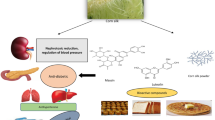Abstract
The powdered roots of moghat (Glossostemon bruguieri) have been traditionally used in Eastern countries for their nutritive and therapeutic value. However, the biological effects of the plant constituents have not been proved on the basis of scientific research. The present study aimed to evaluate the content and composition of proteins and mucilages of the roots and seeds of moghat, as well as the hypoglycemic effect of the mucilages. The crude protein constituted 19.5% of the seeds, while it made up 4.5% of the peeled dried roots ofGlossostemon bruguieri (Moghat). Glutamic acid, proline, leucine, phenylalanine, histidine and arginine were abundant in the protein of both plant parts; 72 and 83%, respectively. Valine, cysteine, methionine and lysine were detected only in seed protein. Molecular weights of the seed proteins were 50 000, 45 000 and 22 000. Moghat seeds contained 5.0% mucilage, while 15.75% and 29.60% were recorded in roots of one- and two-year-old plants, respectively. GLC investigation showed that both these plant parts contained rhamnose, xylose, mannose and galacturonic acid. Arabinose (1.8%) and glucuronic acid (14.6%) were present only in the seeds, while galactose constituted 33.7 to 34.5% of the root mucilage. Age of the roots was reflected in quantitative differences rather than qualitative ones. The root mucilages had remarkable hypoglycemic activity, decreasing the blood glucose level in diabetic rats by 54.5% within 15 days. Accordingly, moghat roots should be investigated as potential medical and nutritive food.
Similar content being viewed by others
References
El-Kiey MA, Hashem FM (1957) A pharmacognostical study of Egyptian moghat. Proc Pharmaceutical Society of Egypt 39: 12–20.
Fouad AM (1989) A phytochemical study ofGlossostemon bruguieri Desf., growing in Egypt. M.Sc. Thesis, Faculty of Pharmacy, University of Cairo, Egypt.
El-Gengaihi S, Turkey KA, Shalaby AS, Ibrahim NA (1995) Effect of fertilization treatments on yield parameters and mucilage and fat contents in roots of moghat (Glossostemon burguieri Desf.). Plant Foods Hum Nutr 47: 239–244.
Soldati F, Tanaka O (1984) Relation between age of plant and content of ginsenosides. Planta Medica 51 (4): 351–352.
Hames BD (1981). Gel electrophoresis of proteins, a practical approach. Hames BD and Richwood D eds. London: IRL Press Ltd.
Laemmli UK (1970) Cleavage of structural proteins during the assembly of the head of bacteriophage T4. Nature 227: 680–685.
Laidlaw R, Percival EG (1949) J Chem Soc 2: 1603 (cf Karawya MS, Wassel GM, Baghdadi HH, Ammar NM (1980) Mucilages and pectins of opuntia, tamarindus and cydonia. Planta Medica: 68–75).
Sweeley C, Bently R, Makita M, Wills W (1963). J Am Chem Soc 85: 2498 (cf. Karawya MS, Wassel GM, Baghdadi HH, Ammar NM (1980). Mucilages and pectines of opuntia, tamarindus and cydonia. Planta Medica: 68–75).
Medeiros MA, Medeiros FC, Peixoto MM, Silva JC, Rao VS, Matos ME, Craveiro AA (1992) Hypoglycemic activity ofBignonia tuira aqueous extract in rats. Fitoterapia 63: 363–364.
Trinder P (1960) Determination of glucose in blood using glucose oxidase with alternative oxygen acceptor. Ann Clin Biochem 6: 24.
Handa SS, Chawla AS, Maninder A (1989) Hypoglycemic plants: A review. Fitoterapia 60: 195–224.
Madar Z (1984) Fenugreek (Trigonella foenum-graecum) as a means of reducing post-prandial glucose level in diabetic rats. Nutr Rep Int 29: 1267–1273.
Tomoda M, Shimizu N, Oshima Y, Takahasi M, Murakanu M, Hikino H (1987) Hypoglycemic activity of twenty plant mucilages and three modified products. Planta Medica 8–12.
Author information
Authors and Affiliations
Rights and permissions
About this article
Cite this article
Ibrahim, N., El-Eraky, W., El-Gengaihi, S. et al. Chemical and biological evaluation of proteins and mucilages from roots and seeds ofGlossostemon bruguieri Desf. (Moghat). Plant Food Hum Nutr 50, 55–61 (1997). https://doi.org/10.1007/BF02436043
Received:
Accepted:
Issue Date:
DOI: https://doi.org/10.1007/BF02436043




